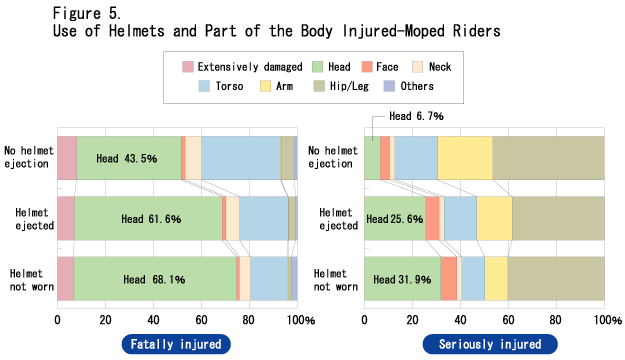
|
Fatality rates among two-wheeled vehicle riders and passengers were compared for "No helmet ejection",
"Helmet ejected", and "Helmet not worn" (Figure 4), using data from 1995 through 2004.
Fatality rate means the percentage of fatalities among casualties. The fatality rate was highest among riders and passengers whose helmet came off in accidents, both on mopeds and on motorcycles, clearly pointing to the danger of helmet ejection. The reason why the fatality rate is higher in the "helmet ejected" category than in the "helmet not worn" group is not identified, but it is clear that helmet ejection is as deadly as wearing no helmet. Furthermore, the fatality rate of the "helmet ejected" group is 4.6 times higher than the "no helmet ejection" group among moped riders, and 3.0 times greater among motorcycle riders and passengers, underlining the high level of protection provided by helmets. |
|

|
|
Figure 5 shows the part of the body most frequently injured in moped accidents. Among those who were killed, which is shown in the graph on the left, "head" injury accounted for the largest portion: 43.5% for those whose helmets stayed in place, and significantly higher 61.6% for those whose helmets were displaced. The latter figure is close to the 68.1% recorded for unhelmeted riders. Clearly, helmets offer no protection to the head if they come off in an accident.
Among those seriously injured, which is shown in the graph on the right, head injury accounts for a small 6.7% among those whose helmets were not ejected, whereas the ratio was 25.6%, nearly four times greater, among those who experienced helmet ejection. Here again, the figure is close to the 31.9% for helmetless riders. It is again obvious that helmets provided significant protection in accidents in which riders sustained serious injury.
|
|

|
|
|
Although the above analysis was for moped riders only, exactly the same trend exists among motorcycle riders and passengers.
|
|
|
UP
Back Next
|
